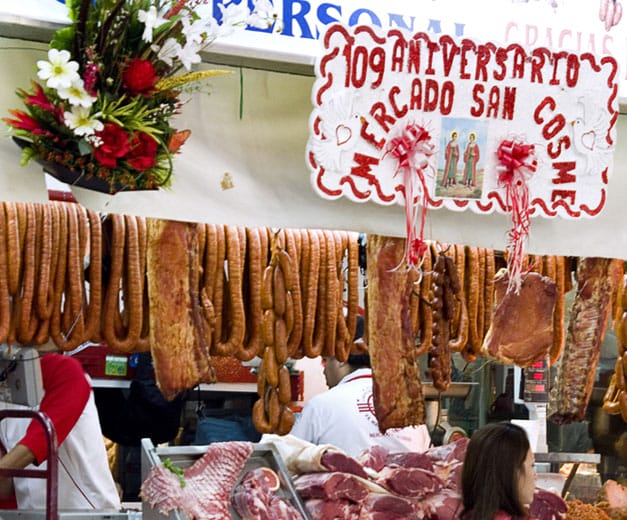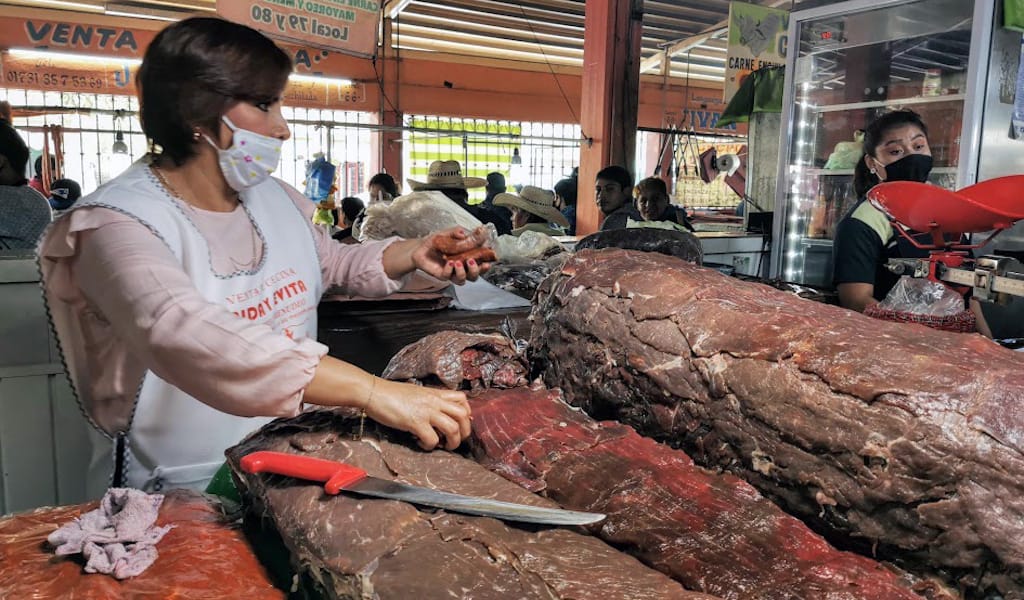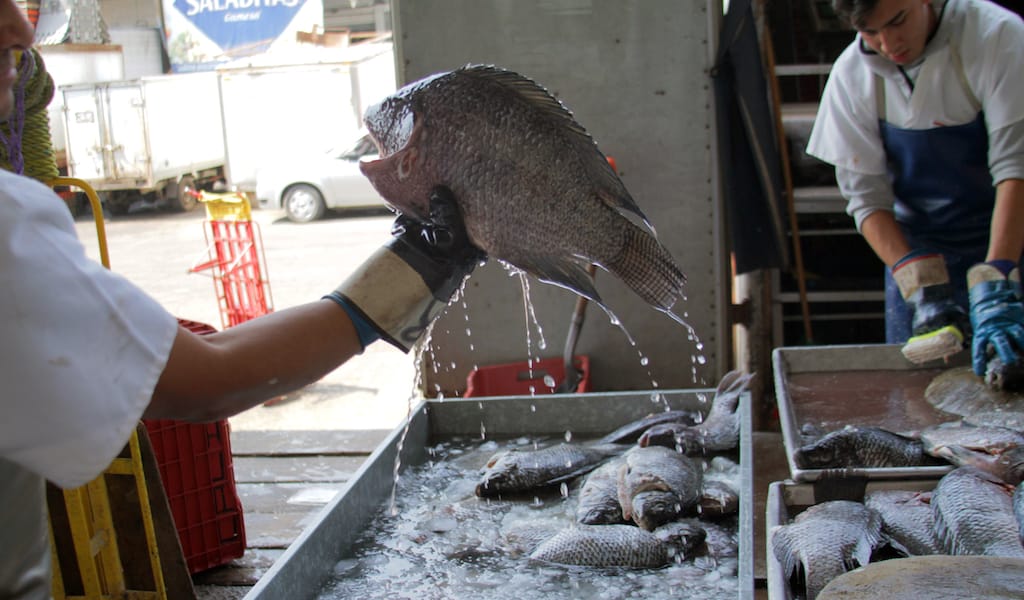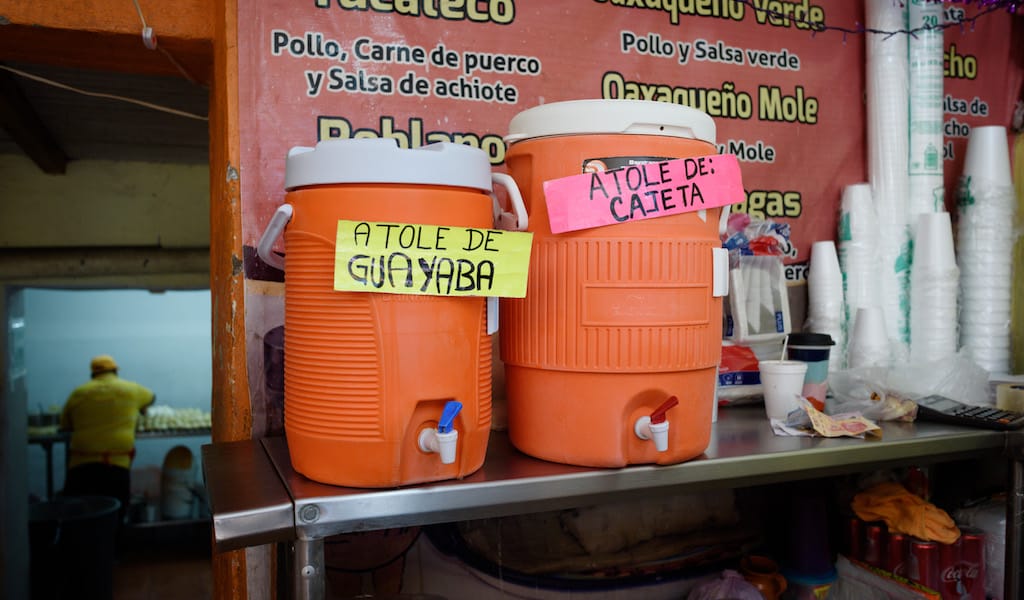Whenever we explore a neighborhood in the city, we look for the tianguis: local markets that serve as a very important part of life in Mexico. Almost everything needed for a household can be found in their narrow and colorful aisles.
Mercado San Cosme is the tianguis in Colonia San Rafael, a beautiful and charming neighborhood that was established in the late 19th century as one of the first formal communities outside of the city center. In the Porfirio Díaz era, San Rafael catered to the wealthy, and the beautiful buildings and façades that still grace the streets there speak to those long-ago days of glory.
Like every other market in Mexico, Mercado San Cosme has what could be considered a food court – though one populated not by fast-food chains but rather by local vendors serving up traditional specialties. Right in the middle of the building, among vegetable stalls and party supplies, there are several establishments that offer comida corrida, tortas and all kinds of fruit juices in a festive and always busy atmosphere. However, the thing that immediately caught our attention was a dazzling display of sweets right outside the market. It’s hard not to stop and stare at the beautifully decorated cakes and jellies. A nice girl, who we now know as corazón, or sweetheart, recited the whole array of cakes available. We tried the tres leches with cajeta and the double-chocolate cake, which were both delicious. On the savory end of the spectrum, we’ve written previously about Quekas San Cosme, a stand that has been selling fried quesadillas, tostadas and pambazos for decades. We’ve been coming to this eatery for several years now and always look forward to our next visit.
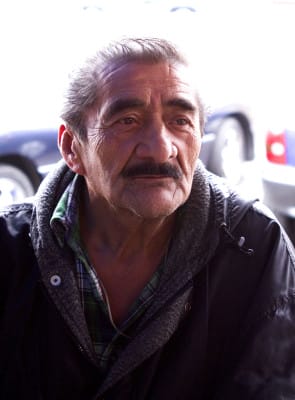 On our last trip to the market, we decided to find out a little more about its history. Everyone we talked to was eager to share what they knew, but many of the vendors also directed us to the flower section, where we were told we would find the person who knew everything about Mercado San Cosme: Agustín Franco. Walking through the flowers, we noticed a wall of photographs and news articles, some very old, many of which pictured the same man – Agustín Franco, as you might have guessed.
On our last trip to the market, we decided to find out a little more about its history. Everyone we talked to was eager to share what they knew, but many of the vendors also directed us to the flower section, where we were told we would find the person who knew everything about Mercado San Cosme: Agustín Franco. Walking through the flowers, we noticed a wall of photographs and news articles, some very old, many of which pictured the same man – Agustín Franco, as you might have guessed.
The congenial man happily gave us a quick history of the market. “If you want the whole story,” he said with a smile, “we would need to sit down for a while.” The market was founded on November 23, 1902, by Porfirio Díaz, then president of Mexico. It was originally at the corner of Cipres and Ribera de San Cosme, a couple of blocks west of its current location. The grounds where the market sits now used to be a cockfighting ring and were subsequently bought by Circo Atayde, one of the oldest circuses in Mexico. In 1953, under Ernesto Uruchurtu Peralta, then head of the Department of the Federal District, Mercado San Cosme was moved to its current location as part of a project to build bigger and better markets.
“Originally,” Mr. Franco told us, “the market was de galeras just like the Merced market” – open and populated with individual sheds – but after a severe hail storm and some problems with buildings sinking in the unstable soil, a stronger structure was erected. “I’m the only person remaining who has lived here all his life,” Franco told us. “Have you lived here in Colonia San Rafael all your life?” we asked. 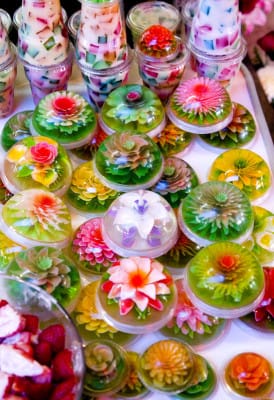 “No, here,” he said, and pointed to the market entrance, smiling when he saw the confusion on our faces. “There used to be a vecindad” – tenement house – “next to the cockfighting ring, and I grew up there. Then the circus came and we worked for them.”
“No, here,” he said, and pointed to the market entrance, smiling when he saw the confusion on our faces. “There used to be a vecindad” – tenement house – “next to the cockfighting ring, and I grew up there. Then the circus came and we worked for them.”
Mercado San Cosme, just like Colonia San Rafael, may have seen better days, but it’s representative of markets throughout Mexico City and Mexico. Shopping in one of these is all about trial and error and always at least a little bit of an adventure. You don’t always find exactly what you need the first time, and not all vendors are of equal quality, but the hunt is part of the fun. It pays to get to know a market and its vendors and history; dig deep and you’ll find treasure.
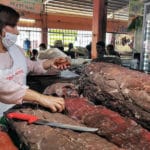 August 27, 2020 CB on the Road
August 27, 2020 CB on the Road
Cecina is a food for the road. In its most common form, the salted and dried meat can […] Posted in Mexico City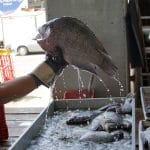 March 10, 2020 Mercado La Nueva Viga
March 10, 2020 Mercado La Nueva Viga
The place smells like a wet dog. The fishmongers have long grown accustomed to it, but […] Posted in Mexico City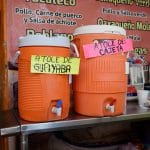 January 2, 2020 Liquid Assets
January 2, 2020 Liquid Assets
Corn is so vital to Mexican cuisine and culture that we could scarcely avoid it even if […] Posted in Mexico City
Published on December 04, 2013
Related stories
August 27, 2020
Mexico CityCecina is a food for the road. In its most common form, the salted and dried meat can last for months, which explains why it was a main source of sustenance for travelers, sailors and soldiers in colonial Mexico. Nowadays, cecina is still known as a thin cut of cured meat – almost always beef…
March 10, 2020
Mexico CityThe place smells like a wet dog. The fishmongers have long grown accustomed to it, but the uninitiated are assaulted by the full force of Mercado La Nueva Viga’s funky barnyard smell almost from Eje 6, the congested avenue were we turn into the entrance. The trick, we find, is to walk quickly into one…
January 2, 2020
Mexico CityCorn is so vital to Mexican cuisine and culture that we could scarcely avoid it even if we wanted to. Not that we would ever want to – one of the things we love most about dining in Mexico is the high likelihood that our meal will have a healthy dose of corn in one…







































